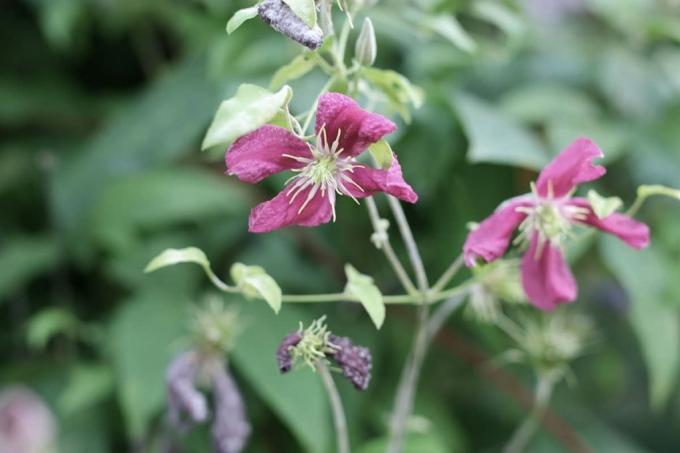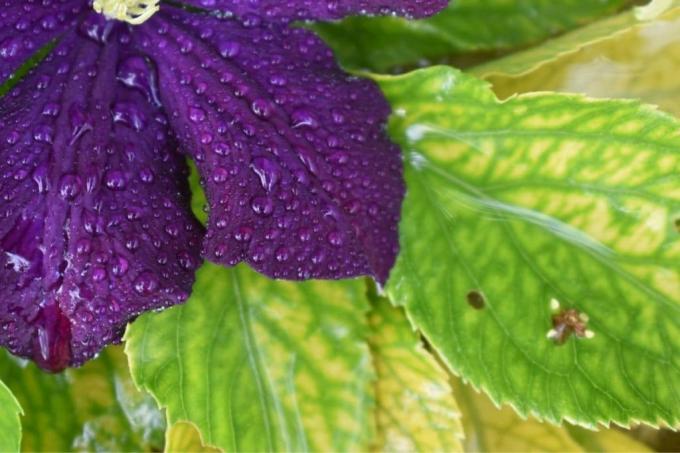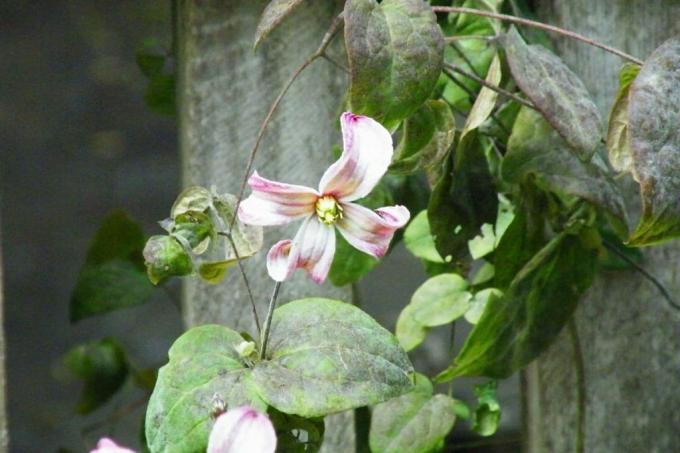
table of contents
- Clematis wilt
- Phoma clematis wilt
- Fusarium wilt (Fusarium oxysporum)
- Prevent clematis wilt
- Iron deficiency chlorosis
- Gray mold
- mildew
- frequently asked Questions
The clematis is one of the most popular climbing plants thanks to its colorful, plate-sized flowers. If it weren't for some leaf diseases on your clematis that make life difficult for plants and hobby gardeners.
In a nutshell
- Clematis, or clematis, is susceptible to a variety of fungus-related diseases
- probably the most feared fungal disease is clematis wilt
- two forms of clematis wilt: the Phoma and the Fusarium clematis wilt
- Game species or large-flowered hybrids rarely affected
- Other leaf diseases are powdery mildew, gray mold as well as bud rot and iron deficiency chlorosis
Clematis wilt
The clematis wilt are actually two leaf diseases on the clematis with a different course, the Phoma and the Fusarium clematis wilt.

Phoma clematis wilt
Causes and symptoms
- the most common form of clematis wilt
- caused by fungal pathogen called Ascochyta clematidina
- Fungus invades the plant through small injuries
- in spring small light brown leaf spots with a yellow halo
- Infestation begins in the lower third
- initially on the undersides of older leaves
- Spots get bigger and darker
- complete sheet is destroyed
- later the shoots wither
- Spread favored by warm, humid weather
Note: All clematis species can be attacked by this leaf disease, but only the large, flowery hybrids die completely above ground.
Combat
- Combat only promising in the early stages
- as long as the shoots are not yet affected
- Completely remove infected leaves
- Dispose of in household waste
- consistently remove leaves lying on the ground
- if necessary shorten the shoot tips a little
- Watch the infestation carefully
- if the leaf disease progresses, cut back close to the ground
- Fungicides can be used after the cut
Tip: If the infected plants are wild species, the Phoma wilt is usually limited to the leaves. It then turns out to be more harmless.
Fusarium wilt (Fusarium oxysporum)
Causes and symptoms
- far rarer than Phoma clematis wilt
- Infestation only at temperatures between 20 and 30 degrees
- from around the second half of June
- Leaves turn brown from the edge
- The discoloration then spreads to the middle of the leaf
- Leaves and shoots above the infestation hang limply
- look like dried up
- The plant dies down to the roots within a short time
- only above-ground parts of the plant are damaged
- Roots are not infected
- can sprout again next year
Combat
- infested plants can usually be saved
- Be sure to remove affected parts of the plant
- Cut the plant back into the sound wood
- possibly also close to the ground
- Dispose of clippings in household waste
- Fungicides ineffective on Fusarium wilt
- Then thoroughly disinfect the cutting tools used
Prevent clematis wilt

- Plant on loose, deep soil
- Choose a rain-protected, well-ventilated location
- Regular control of the plants from May
- do not pour over leaves and shoots
- water and fertilize as needed
- Regularly remove weeds in the root area
- Avoid injuring the plants
- stabilize with rods or supports
- Pay attention to resistant varieties when buying
Iron deficiency chlorosis
This leaf disease is a deficiency disease of the clematis, in this case iron deficiency. Diseased plants suffer from a disorder of their photosynthesis metabolism.
Causes and symptoms
- frequent cause of excessive lime content in the soil
- caused by calcareous irrigation water
- through heavy soils with a high lime content
- or through alkaline, particularly light and dry soils
- other causes are long cold spells, low light intensity and drought
- The first signs are discoloration of the young shoots and leaves
- lose their color and become paler
- from light green to light yellow
- spreads rapidly to older leaves
- Leaf veins initially remain green
- Leaf margins are drying up more and more
Tip: Iron deficiency chlorosis can promote gray mold infestation in clematis.

Control and Prevention
- remove affected leaves
- Apply fertilizer with the missing nutrients
- If necessary, foliar fertilization is recommended
- Nutrients can be absorbed directly
- Work peat into the ground
- Replace the substrate completely in potted or potted plants
- As a preventive measure, it is best to boil tap water
- Improve the soil in the long term, pay attention to the correct pH value
Note: Iron with chelate should not be used for foliar fertilization, as this could damage the leaves permanently. Special leaf fertilizers from specialist retailers are better.
Gray mold
This leaf disease on clematis is also transmitted by a fungus that overwinters on dead plant tissue. Wind and water splashes can keep the spores in the air throughout the growing season.
Causes and symptoms
- leaf disease also known as bleaching or botrytis
- occurs predominantly when potted plants are overwintered without frost
- especially in the greenhouse or winter garden
- responsible is moist, cool and stagnant air
- specimens cultivated outdoors less affected
- Gray mold leaves a grayish, often dusty carpet
- initially on leaves and flowers
- then spreads over the whole plant
- Flowers do not open, those that are already open are stuck together, fall off
- dark brown, rotten spots on young and soft leaves and shoots

Combat
- Usually no countermeasures are required outdoors
- otherwise cut off all affected parts of the plant
- Treat plants with easy-to-make horsetail broth
- from ten liters of water and one kilogram of field horsetail
- Soak the herb in the water for 24 hours
- then bring to the boil and simmer gently for about 30 minutes
- Strain after cooling
- Spray infested plants once or twice a day
- over a period of four to five days
- then ensure good ventilation
- in extreme cases treat with sulphurous preparations
prevention
- make sure there is sufficient distance to other plants
- Avoid damp and low-light locations
- Leaves should dry off quickly after rain
- water and fertilize in moderation
- Do not wet leaves and flowers with irrigation water
- ideally water in the morning
- Avoid over-fertilization, especially with nitrogen
- Plants with plant broths e.g. B. Starch made from field horsetail
mildew
Powdery mildew is a common fungal disease. When infected with this leaf disease, the fungi deprive the clematis of nutrients. This not only results in visual impairments.
Causes and symptoms
- mainly in wet and cool and dry and humid weather
- favored by temperatures above 20 degrees
- Plants in dry, poorly ventilated locations are particularly endangered
- large-flowered hybrids more often affected
- floury-white coating on the upper side of the leaves
- also reddish and brownish spots on the leaves
- as a result, the leaves dry up

Combat
- Treat the infestation as early as possible
- Milk is a tried and tested remedy for initial infestation
- to do this, mix 900 ml of water with 100 ml of fresh milk
- Spray the top and bottom of the leaves with it
- Microorganisms in milk fight the fungus
- Repeat treatment about every three days
- Long-life milk is unsuitable and contains hardly any microorganisms
- Biological pesticides based on sulfur or copper are used against severe infestation
Tip: An effective alternative to milk is whey. Or you can use a spray solution made from a liter of water, a tablespoon of rapeseed oil and a packet of baking powder. With these solutions, many leaf diseases on clematis can be combated.
prevention
- Make sure there is sufficient spacing and good ventilation
- Water as needed, mulch the soil
- Sources of infection such as B. Minimize weeds
- prefer hardy plants
- natural predators like Ladybug lure into the garden
frequently asked Questions
The large-flowered and the hybrid varieties that bloom on old wood suffer from clematis wilt. Much more robust are numerous wild species and hybrid varieties that bloom on this year's wood (Jackmanii group). Some perennial clematis as well as the clematis 'texensis', 'viticella' and 'recta' are particularly susceptible to powdery mildew.
Soil fatigue, as we know it from roses, for example, does not usually occur in clematis. However, if the plant died from a wilting disease, a generous soil exchange is recommended.
The planting distances depend on the respective variety. In the case of the alpine clematis' Clematis alpina 'this is 50-80 cm, in the case of the Italian ‚Clematis viticella' 60-100 cm, the clematis 'Clematis montana' needs 100-150 cm and for the common clematis 'Clematis vitalba' distances of 200-400 cm are required recommended.



